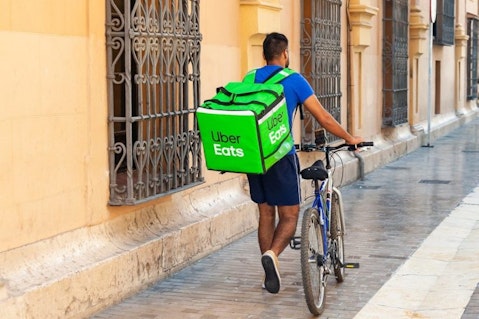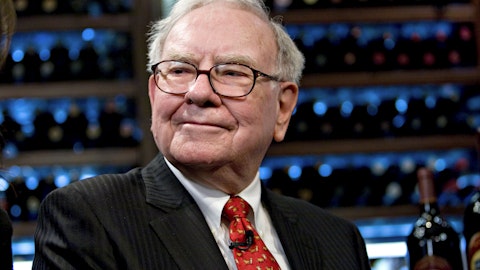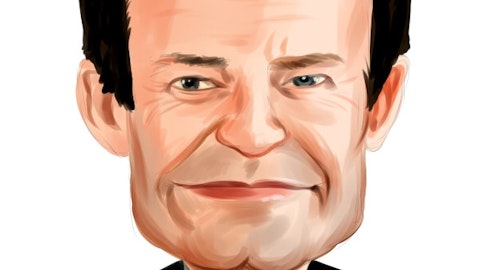Uber Technologies, Inc. (NYSE:UBER) Q4 2022 Earnings Call Transcript February 8, 2023
Balaji Krishnamurthy : Thank you, Angela. Thank you for joining us today and welcome to Uber’s fourth quarter 2022 presentation. On the call today we have Uber CEO, Dara Khosrowshahi and CFO, Nelson Chai. During today’s call, we will present both GAAP and non-GAAP financial measures. Additional disclosures regarding these non-GAAP measures, including the reconciliation of GAAP to non-GAAP measures are included in the press release supplemental slides and our filings with the SEC, each of which is posted to investor.uber.com. As a reminder, these numbers are unaudited and may be subject to change. Certain statements in this presentation and on this call are forward-looking statement. Such statements can be identified but such as believe, expect, intend and may, and you should not place undue reliance on forward-looking statement.
Actual results may differ materially from these forward-looking statement and we do not undertake any obligation to update any forward-looking statement we make today, except as required by law. For more information about factors that may cause actual results to differ materially from forward-looking statement, please refer to the press release the issue today as well as risks and uncertainties described in our most recent annual report on Form 10-K for the year ended December 31, 2021, and in other filings made for the SEC went public. We published our quarterly earnings press release, prepared remarks and supplemental slides to our Investor Relations website earlier today. And we ask you to review those documents if you haven’t already. We will open the call to questions following brief opening remarks from Dara.
With that, let me hand it over to Dara.

Dara Khosrowshahi: Thanks, Balaji. We delivered our strongest quarter ever in Q4, with gross bookings of 26% year-on-year on a constant currency basis. Adjusted EBITDA of $665 million exceeded the high-end of our guidance for the sixth quarter in a row and we delivered strong incremental adjusted EBITDA margin of 12%. We’ve reached several new modes phones this quarter. We crossed 2 billion quarterly trips, and our Mobility consumer base exceeded $100 million for the first time in our history. At the same time, we’re laser-focused on making Uber the best platform for earners, with over 5.4 million people earning on Uber around the world, another all-time high. Put simply, the Uber platform has never been stronger and we’re making great progress building on our platform advantage through advertising and membership.
Despite any macroeconomic uncertainty, I’m more confident than ever in our prospects. We’re entering the year with great momentum. Mobility trip growth is accelerating and Delivery remains resilient. But we are far from complacent, and we’ll continue to hold ourselves to high standards of growth and profitability to deliver yet another record year in 2023. With that, let’s open it up to questions.
A – Balaji Krishnamurthy : Angela, please, do you have questions?
See also 10 Hot Healthcare Stocks To Buy Now and Michael Burry Stock Portfolio: 10 Stocks He Sold.
Q&A Session
Follow Uber Technologies Inc (NYSE:UBER)
Follow Uber Technologies Inc (NYSE:UBER)
Operator: Your first question comes from the line of Eric Sheridan with Goldman Sachs. Please go ahead.
Eric Sheridan : Thanks so much. Maybe two questions, if I could. Dara, as you think forward to 2023 and you sort of aligned an array of products between Delivery and Mobility, how should we be thinking about Uber One as a subscription product? And elements of either leaning in behind growth and pushing adoption of the product to create a wider moat around the collection of assets you have versus maybe just letting virality build around the subscription product. How do we think about active versus approach to driving the subscription element of the business? And then obviously, one of the more recurring themes during the earnings season has been elements of continued efficiency and cost cutting within organizations. You guys have laid out an incremental margin strategy, but how should we be thinking about your broader views on efficiency inside the organization, especially with respect to some of the corporate costs inside the company’s cost structure? Thanks so much.
Dara Khosrowshahi : Yeah, absolutely, Eric. So in terms of Uber One, we think Uber One is a terrific membership program. It’s the only one. If you think about the Uber One benefits, we think about that as content. So Uber One has the best content in terms of Mobility subscriptions and movement subscriptions than any other similar subscription. We got over 12 million members up, with membership having nearly doubled for 2022, which is terrific. And our efforts here are quite active. I mean, we are pushing Uber One. You’ll see it on our delivery services. You’ll see it on our Mobility service. And we are quite actively continuing to innovate in terms of the benefits that we offer, and the results are pretty spectacular. Members spend monthly 4.1 times the amount that nonmembers do on a monthly basis.
So it creates great stickiness. And member retention is 15% greater than non-member retention. So in-period, in the initial months in which we acquire a member, that member is actually loss-making because the discounts that we offer are greater than the in-period value of that 4.1x. But over the lifetime of the member, the membership creates a significant moat and a significant growth opportunity for our business. You will see membership counts continue to increase. And you’ll see the percentage of our bookings coming from membership continue to increase as well. Globally, about 25% of our gross bookings come from members. In the U.S. for example, 40% of our Delivery, gross bookings come from members and it’s a moat that we will continue to actively develop now.
Nelson, do you want to talk about cost?
Nelson Chai : Sure. So Eric, for us, as you probably recall, our call to action moment was actually in 2020. And if you recall back then, our Mobility business was over 85% of the company’s gross bookings. And as we sat here in April of 2020, that business was down 80%. So as you recall, we acted pretty decisively during that time, we took over $1 billion of costs out of our infrastructure. We shuttered down a bunch of businesses. And unfortunately, we did have to let go over 20% of our headcount. So we’ve been really focused on efficiency since then. I think you’ve heard us lay out our plans, and I think Dara mentioned on CNBC, in 2021, we wanted to really push hard for EBITDA profitability, and again, we achieved that metric in 2021.
Last year, we talked about being free cash flow positive at some point in the year. And again, we achieved that metric. And now, we’re talking about being GAAP operating profit at some point later in the year. And we expect to continue to achieve that metric. Now we’ve done this — and you mentioned incremental margins, we’ve done this because we focused efficiently on cost, and we’ve been laser-focused on it. So our headcount will largely be relatively flat this year. And even if you go back to the build that the many companies had over the past few years, we’ve grown our headcount about 10%, excluding the Freight business, over the period of time. And our gross bookings went from $62 billion in 2019 to $115 billion last year. So just think about that growth and efficiency.
Where we’ve hired heads has been in some areas of tax, selectively, as well as some sales folks on the Delivery business. And you can see that it’s certainly been beneficial. So our goal is really to drive the income margins we laid out last year at Investor Day. I think we’ve overachieved against all of the metrics on the profitability side. And again, as Dara mentioned, the year started off quite well, which is why you saw us raise guidance for the first quarter. And we’re going to just continue to leverage our cost base, which is driving the incremental margins that you’re seeing the throughput on.
Eric Sheridan : Great. Thank you.
Balaji Krishnamurthy : Next question?
Operator: Your next question comes from the line of Brian Nowak with Morgan Stanley.
Brian Nowak : Thanks for taking my questions. I have two. The first one on frequency and engagement on the platform. You’ve made really good progress. Now you’re, I think, 5.4 trips per month versus about 5 last year, but still below I think the peak levels Dara used to talk about in 2019. I guess the question on frequency is, where have you made the most progress, sort of getting that frequency per rider up? And how do you think about the key drivers throughout ’23 to sort of get that back to 2019 levels and beyond? And then the second one is on the incremental margins. The Delivery incremental margins continue to deliver above your Analyst Day targets. Anything we should think about that are sort of one timish in nature or different competitive dynamics as to why the incremental margin in Delivery shouldn’t stay at these elevated levels as we go throughout 2023? Thanks.
Nelson Chai : So I’ll handle the first one — Dara will. I’ll handle the second part of that. So if you think about the incremental margins on the Delivery business, yeah, we’ve been very pleased with the throughput. It’s been about over 20% if you think about last year. And it’s really been driven by three areas, right, maybe four. But we really did focus on efficiency in the marketplace. And we have benefited from the fact that a lot of the players are trying to follow our path to profitability, especially the private companies as external money has been harder to come by. So that benefit has certainly been there, and we believe that will continue. Our own technology gains on really improving the efficiency of our cost per transaction.
And I think you’ll recall, we talked about it a fair amount in our third quarter call where we saw a little bit of a step function improvement there. And so we — again, we expect that to do, and that’s on batching and things like that, and we’ve seen the benefit on that. And then frankly, we’ve augmented the margins on new business. And so our Ads business continues to outperform the targets that we laid out. And so the combination of all three of those is really driving the incremental margins that you mentioned there. And so we don’t necessarily see them changing so much. The pace of the improvement will — certainly will slow down.





